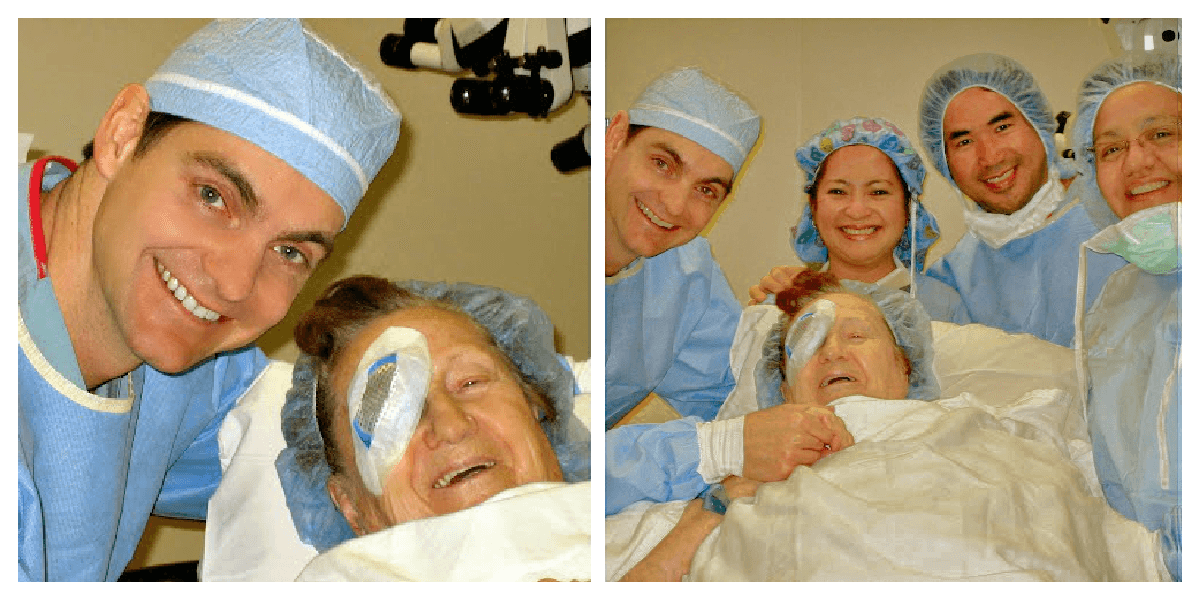The big day has arrived. No doubt, you will feel some anxiety the morning of surgery. Relax. Most people say it’s not nearly as scary as they expected and that the anticipation is worse than the surgery itself.
Get a ride to the surgical center because you will not be able to drive home after surgery; you could be very woozy from any sedatives that may be given to you. See your ride to the center as an opportunity to reflect on how your surroundings look. Very soon, your world is going to be clearer, brighter, and more vibrant!
[su_note note_color=”#f9f9f9″]A Quick Reminder: Do not eat or drink anything the morning of surgery. It is okay to take very small sips of water with your medications that morning, but nothing else. No coffee. No orange juice. Nothing other than very small sips of water to swallow your medications. If you forget and do eat or drink something, your surgery may be delayed or even rescheduled to another day.[/su_note]
At the Surgery Center
When you arrive at the surgery center, chances are there will be some additional paperwork to fill out. After you finish this, someone will take you into a pre-op area, where you may need to change out of your clothing and into a patient gown.
Normally, staff will ask you multiple times which eye is undergoing cataract surgery. You may be thinking, “Don’t they know? Maybe I’m at the wrong place.” There’s no need for worry. Surgical staff are often instructed to check and re-check to ensure they are operating on the correct person and the correct eye. At some point before surgery actually begins, your surgeon might even put a pen mark on your forehead above the eye. This is for your protection and serves as a reminder to everyone which eye is to be operated on. After surgery, you can remove this mark with an alcohol swab or let it disappear on its own after a few days.
Either in the pre-op area or the operating room, you’ll have an intravenous (IV) line placed in your arm. You’ll also have drops placed in your eye multiple times. The drops dilate your pupil, making it easier for the surgeon to get a clear view inside your eye. It may take 20 to 60 minutes for your eye to dilate enough for surgery. Be patient. The larger your pupil, the better your surgeon’s view into the eye.
Once in the operating room, you’ll most likely be there for 45 minutes to an hour. About half of this time will be spent cleaning the area around your eye and placing a drape over your upper body. This protects your eye from any bacteria that could cause an infection.
A blood pressure cuff will be placed on one of your arms. Don’t be alarmed. It is routine to monitor blood pressure during surgery. The cuff will periodically inflate and squeeze your arm. Just try to relax and ignore it. It will deflate soon.
You’ll most likely be given a sedative through the IV to relax and bring you into a state called conscious sedation. This is not like general anesthesia, where you’re unconscious. Instead you’re brought into a sleepy, relaxed state.
I find that playing music during the procedure further relaxes patients. If you have a particular type of music you would like to play during the surgery, let your surgeon know. I offer my patients the opportunity to choose from more than 9,000 songs on my iPod, or I let them bring in their own CD or digital music player.
One of the effects of the sedative is temporary amnesia, so don’t be surprised if you don’t remember what happens next.
To numb the eye, your surgeon will give you either an injection of numbing medication or topical anesthetic. Traditionally, numbing medication is injected next to and behind the eye. This requires using a needle, which could potentially puncture the eye and lead to a loss of vision. For this reason, I prefer to use a topical anesthetic, which does not require an injection. Topical anesthetic is a liquid or gel applied to the surface of the eye prior to surgery.
There are multiple benefits of topical anesthetic — the main one is avoiding the risks associated with using a needle next to the eye. (Recall what your mother told you about sharp objects and the eye. The same motherly wisdom applies here.) Also, an injection often makes a patient’s vision blurry for several hours after surgery. With topical anesthetic, you’ll be able to enjoy your improved vision shortly after surgery.
While you’re still in a relaxed, sleepy state, your surgeon will begin the procedure. Typically two things will happen next: You’ll hear buzzing and bells coming from the equipment and possibly feel some cool fluid on the side of your face. The fluid helps keep the ultrasound cool and is nothing to worry about.
While your surgeon is removing your cataract and replacing it with an intraocular lens (IOL), you might feel pressure in your eye. However, you should not feel any pain during the surgery. If you do, let the surgeon know so that you can be given more anesthetic.
When the procedure is over, your surgeon will place a protective eye shield over your eye. You’ll need to wear the shield continuously for the next 24 hours and then only when sleeping or napping for the week after surgery.
Staff will then transfer you to a recovery area for an hour or so where you’ll recover from the IV sedation. The entire process — from the time you arrive at the surgery center to the time you leave typically takes 2 to 4 hours.

After the Procedure
The afternoon and evening following surgery, it’s normal to feel as if there is something in your eye, such as a grain of sand. This usually lasts for only a few hours, but can last up to a few days. Using the eye drops prescribed to you before the surgery can relieve the discomfort. Although it seems obvious, I’ve learned the hard way never to assume anything, so I’m going to say it: [su_highlight background=”#ff8c00″]Don’t rub your eye![/su_highlight]
You may be prescribed more eye drops. These will help prevent infection and treat the inflammation caused by surgery.
You should not experience significant pain. If you do, call your surgeon. If needed, you may take acetaminophen for minor discomfort. Try to avoid aspirin or non-steroidal anti-inflammatory drugs (NSAIDs), such as Advil® and Aleve®, as they increase the chance of bleeding.
Your surgeon will likely tell you to take it easy for the rest of the day. Watching TV is generally what I recommend. This is a great time to get the family to wait on you. Let someone else make dinner for a change.
You may still be groggy from the sedative, so don’t try to operate any machinery (such as a car). It’s okay to read, but your vision may seem “jiggly.” Because the lens capsule has not yet contracted around the IOL, there may be a slight jiggle of the lens with each eye movement. This is most noticeable when reading and will improve over the next few weeks.
The evening of surgery, your vision may or may not be already restored. However, even by that evening, many people notice that they can see things more clearly through the holes of the eye shield.
[su_note note_color=”#f9f9f9″]Do surgeons ever operate on both eyes at the same time? If you have cataracts in both eyes, you’ll have surgery done on one eye at a time. Typically, you’ll have surgery on the first eye and a second surgery on the second eye a month or so later. This will give your first eye enough time to heal before you undergo surgery on the other eye.[/su_note]








Leave a Reply